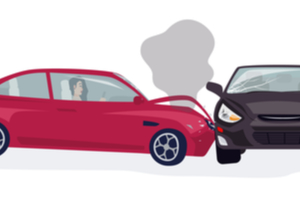 Collisions between motor vehicles can be devastating. While there are multiple types of car accidents that can occur in various locations, many collisions take place at intersections, and they are often caused by drivers who do not obey signs or traffic signals. When a person proceeds through an intersection without checking that it is clear or runs a red light or stop sign, this may result in a side-impact collision. These are also known as T-bone accidents, since the position of the two vehicles resembles a letter T. These collisions can be very dangerous, and they may involve a strong impact and cause serious harm to the bodies of the driver and passengers in a vehicle that is struck.
Collisions between motor vehicles can be devastating. While there are multiple types of car accidents that can occur in various locations, many collisions take place at intersections, and they are often caused by drivers who do not obey signs or traffic signals. When a person proceeds through an intersection without checking that it is clear or runs a red light or stop sign, this may result in a side-impact collision. These are also known as T-bone accidents, since the position of the two vehicles resembles a letter T. These collisions can be very dangerous, and they may involve a strong impact and cause serious harm to the bodies of the driver and passengers in a vehicle that is struck.
Types of Injuries in Side-Impact Crashes
When one vehicle strikes another vehicle from the side, this may directly impact a driver or passenger. In high-speed collisions, the door or frame of a vehicle may be forced into the vehicle’s interior, causing harm to multiple parts of a person’s body. While people on the same side of the vehicle that is struck are most likely to suffer injuries, those who are on the opposite side may also be injured. Some common injuries that can occur in these situations include:
- Soft tissue injuries – The impact in a T-bone collision can cause damage to a person’s muscles, ligaments, tendons, or internal organs. Sprains and joint dislocations are common in these accidents, and torn ligaments or severed tendons can also occur. These injuries can seriously limit a person’s ability to use their arms, legs, or other parts of their body, and they may require ongoing treatment and physical therapy to fully restore their range of motion.
- Broken bones – The force of being struck by another vehicle can cause fractures in multiple parts of the body. The clavicle (collarbone) is one of the most commonly broken bones in T-bone collisions, but fractures can also occur in the arms, legs, ribs, or hips.
- Traumatic brain injuries – While airbags may deploy in a collision and provide some cushioning meant to protect a person’s head, they may not fully prevent a vehicle’s door or frame from striking the head and causing brain injuries.
- Whiplash and spinal cord injuries – The jolting impact of a T-bone accident may cause a person’s head and neck to snap to the side, causing damage to the vertebrae in the neck, as well as the muscles, tendons, and ligaments in the neck and shoulders. This can lead to pinched nerves and restrictions on range of motion, as well as other ongoing issues. The impact of a collision may also affect the vertebrae in the back, potentially leading to issues such as herniated discs or damage to the spinal cord that may cause partial or total paralysis.
- Serious lacerations – Glass and metal fragments may cause serious cuts and lacerations on multiple parts of the body. When these injuries affect the face or upper torso, they may lead to significant scarring and disfigurement.
Contact Our Green Bay T-Bone Collision Lawyers
If you have been injured in a side-impact collision, it is likely that another driver’s negligence was to blame. The lawyers of Herring Clark Law Firm, Ltd. can help you take legal action to recover compensation for your injuries and damages. We will work with you to gather the necessary evidence, such as footage from traffic cameras at the intersection where the collision occurred, testimony from eyewitnesses, and reports from police officers called to the scene. To arrange a free consultation, contact our Appleton car accident injury attorneys at 920-739-7366.
Sources:
http://www.ircobi.org/wordpress/downloads/irc17/pdf-files/20.pdf
https://www.ncbi.nlm.nih.gov/pmc/articles/PMC5045916/
https://pubmed.ncbi.nlm.nih.gov/26660741/


